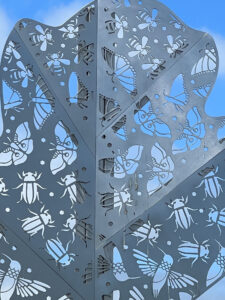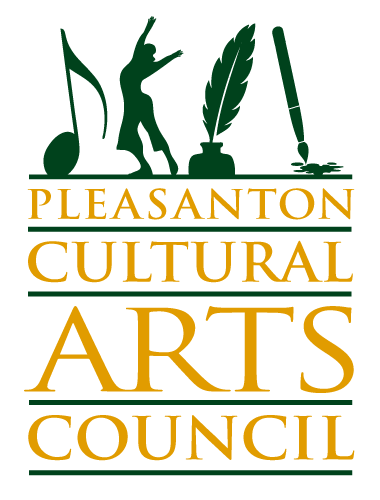Nurturing Open Space
 Standing gracefully tall, a 9-foot Blue Oak sculpture mounted on a two-foot base proudly watches over the pollinator realm on a hill in the northwest corner of Bernal Park. The high gauge laser-cut stainless-steel leaf is etched with butterflies, hummingbirds, bees, moths, and beetles in celebration of the pollinators that contribute to Pleasanton’s biodiversity. Critical pollinators form the foundation for all life, contributing to our local habitats and interacting with food locally grown.
Standing gracefully tall, a 9-foot Blue Oak sculpture mounted on a two-foot base proudly watches over the pollinator realm on a hill in the northwest corner of Bernal Park. The high gauge laser-cut stainless-steel leaf is etched with butterflies, hummingbirds, bees, moths, and beetles in celebration of the pollinators that contribute to Pleasanton’s biodiversity. Critical pollinators form the foundation for all life, contributing to our local habitats and interacting with food locally grown.
Can you see the dancing pattern of pollinators on the sculpture? The bees at the top of the leaf are Mason/Cotton Bees (Megachilidae), the beetles are Ten-Lined June (Polyphylla decemlineata) and the Hummingbirds are Allen’s Hummingbird (Selasphorus sasin). Various species of moths and butterflies seem to float throughout the leaf with their winged patterns catching the light of day and reflecting sunset at curious angles.
 Artist Deedee Morrison envisioned the California Blue Oak leaf as a symbol of resilience. The blue oak has an extensive root system and can grow through cracks in rocks to a depth of 80 feet to reach groundwater. It generally is a medium-sized tree, growing between 20-66ft tall. It is deciduous. One Blue Oak is planted in Bernal Park. Look for a bark that is light gray with many medium-sized dark cracks; from a distance, it may appear to be almost white. The leaf will have a slightly bluish tinge of color and the rounded shape of the leaf sculpture. Acorns dropped from Oak trees are consumed by scrub jay, band-tailed pigeons, California quail, western gray squirrel, the California ground squirrel, and deer. In total, there are five Oak trees planted in Bernal Park, two evergreen trees (Interior Live Oak and Coast Live Oak) and three deciduous (Valley Oak, Blue Oak, and Black Oak). Valley Oak is the most abundant in the Pleasanton Valley.
Artist Deedee Morrison envisioned the California Blue Oak leaf as a symbol of resilience. The blue oak has an extensive root system and can grow through cracks in rocks to a depth of 80 feet to reach groundwater. It generally is a medium-sized tree, growing between 20-66ft tall. It is deciduous. One Blue Oak is planted in Bernal Park. Look for a bark that is light gray with many medium-sized dark cracks; from a distance, it may appear to be almost white. The leaf will have a slightly bluish tinge of color and the rounded shape of the leaf sculpture. Acorns dropped from Oak trees are consumed by scrub jay, band-tailed pigeons, California quail, western gray squirrel, the California ground squirrel, and deer. In total, there are five Oak trees planted in Bernal Park, two evergreen trees (Interior Live Oak and Coast Live Oak) and three deciduous (Valley Oak, Blue Oak, and Black Oak). Valley Oak is the most abundant in the Pleasanton Valley.
Morrison is a nationally known Alabama public artist, working at the forefront of designing laser-cut sculptures with advanced fabrication technology. Her sculptures have a powerful visual presence while paying tribute to nature’s beautiful efficacy and inspiring curiosity about environmental stewardship. Morrison strongly believes, “Pollinators are a keystone species, essential for plant reproduction and vital to maintaining a healthy ecosystem. They help produce diverse plants that can better weather changes in the environment.”
The Nurturing Open Space sculpture was commissioned by the City of Pleasanton and installed in 2019 at the Oak Woodland section of Bernal Park. To visit this sculpture, park your car in the Bernal Sports Park lot, take the trail going Northwest, turn right at the first opportunity, and follow the upland trail to the sculpture. Come celebrate the distinct patterns of pollinators who need protection to continue their work for you!
Jan Coleman-Knight
